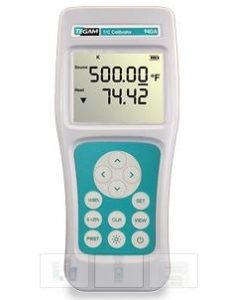Using Temperature Calibrators for Circuit Diagnostics
已发布 六月 24, 2019 由 Advanced Energy Editor

Editor’s note: An updated version of this post appears here.
Did you know that you can use your temperature calibrator as a diagnostic tool to troubleshoot your temperature control circuit?
A temperature calibrator, sometimes known as a process calibrator or temperature simulator, needs a combination of features to make it a useful diagnostic tool. It needs a dual display – one for the output and one for the input, as well as Source and Read. It also needs the output (source) and input (read) channels to be independent functions so that the temperature controller can simultaneously SOURCE and MEASURE in your circuit.
Simultaneous SOURCE and MEASURE with a Temperature Calibrator
Using the two independent displays AND independent input and output channels, temperature calibrators can simultaneously Source a highly accurate thermocouple signal to a controller, and also Measure the output of a thermocouple in the process so that you can verify that the controller circuit and its heater are working properly end-to-end. Thus, you know what signal is going to the controller so you know at what temperature your system should stabilize.
Transfer Mode
When troubleshooting a system with a thermocouple transmitter in-line with the controller, you can use the calibrator’s Transfer mode to verify the entire system end-to-end – the transmitter, the system thermocouple and the signal cabling.
Transfer Mode in a System with a Transmitter:
Select Transfer mode, then connect the system’s thermocouple to the input of the temperature controller and connect the output channel to the transmitter. The temperature controller will read the system thermocouple connected to its input and then automatically re-transmit that signal to the transmitter.
Here you validate the thermocouple reading and create a valid input to the transmitter – eliminating ground loops and electrostatic noise, as well as being able to view open or intermittent circuit connections. The retransmitted signal is displayed on the Source Display. This validates the signal going to the transmitter. You should quickly be able to determine if there is a problem with the transmitter by reading the upstream instrument or by verifying the controller setting by reading the thermocouple signal you are retransmitting. The Transfer Mode gives you end-to-end system check with a system including a transmitter.
Transfer Mode in a System with No Transmitter:
The Transfer Mode is just as valuable in a thermocouple circuit without a transmitter. Connect the thermocouple into the input channel and the downstream instrument into the source channel and you can watch how your system performs. You can read the temperature from the thermocouple and validate that this is the signal being sent to the meter or control circuit. This is a quick and easy way to validate that the wiring and sensing circuit is working properly.
Both the Advanced Energy's TEGAM 940A thermocouple temperature calibrator and the 945A thermocouple temperature calibrator have these features available for utilization, which are not normally found together in one temperature calibration instrument. TEGAM offers this innovation as part of our ongoing pursuit of excellence in electronic and digital measurement instrumentation to our many customers around the globe!
Please contact us here if you have questions or comments, and thanks for reading.
Advanced Energy Editor
Advanced Energy
